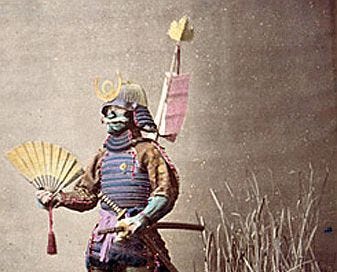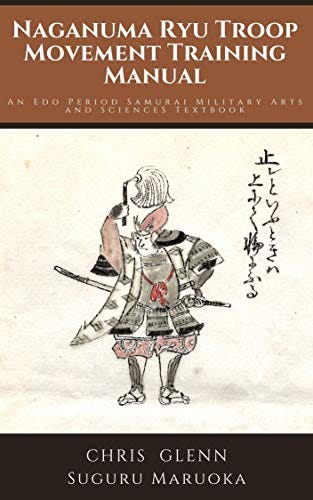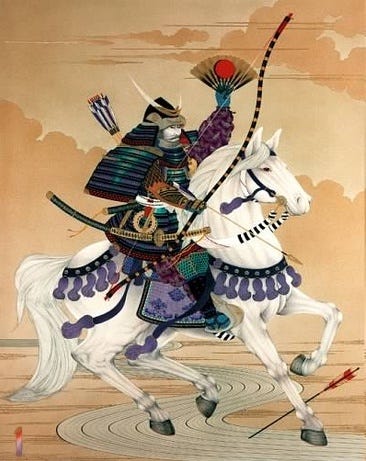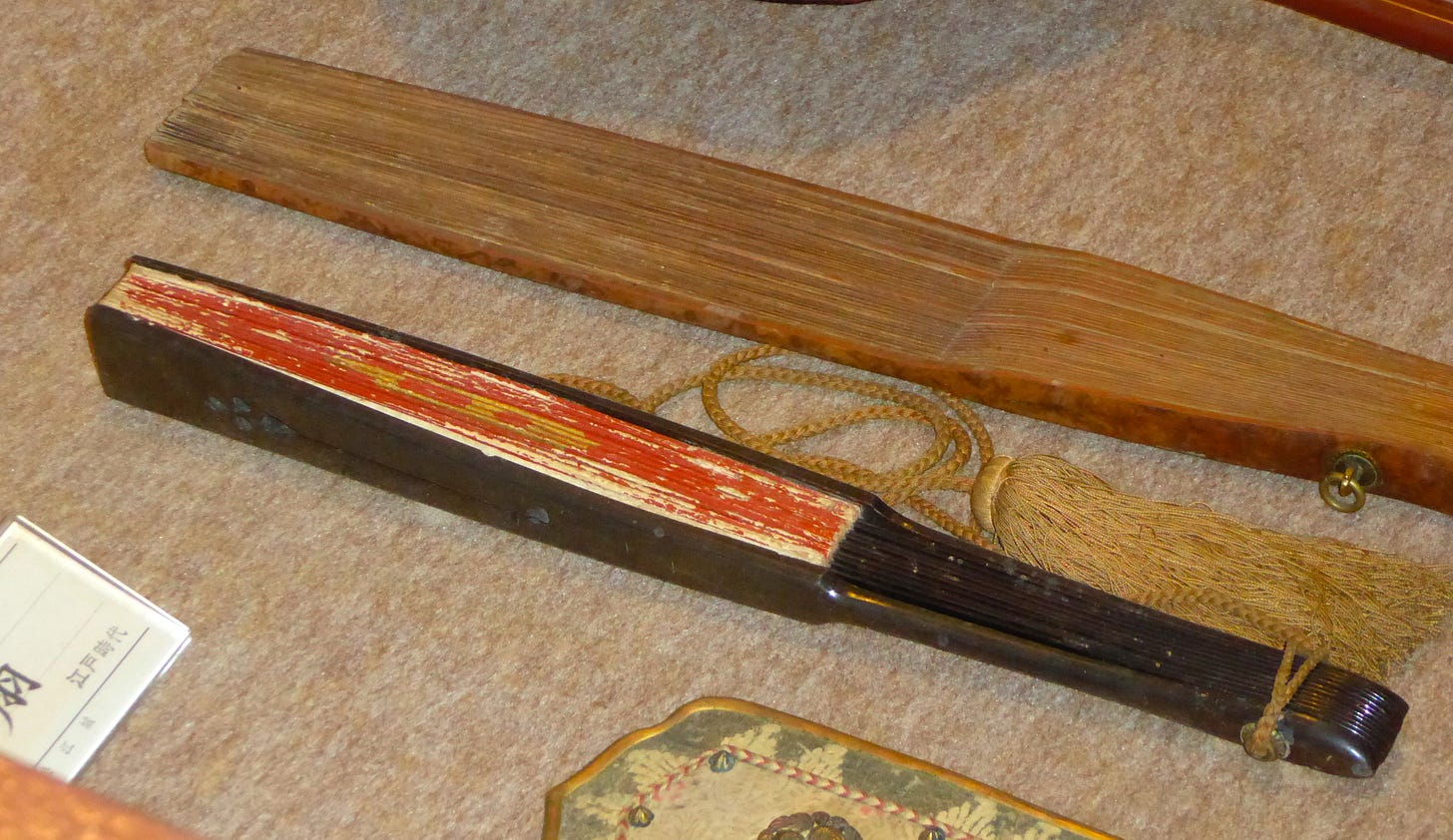Samurai Fighting Fans
Daily Use Cultural Items, Weapons and Communication Devices
Samurai were expected to always carry a sensu, a folding fan and sheets of paper with them, along with the two swords of their station.
There is a long history regarding the usage of fans, with pictures of the earliest Japanese fans recorded on the walls of 6th century burial tombs. Chinese official historical record of the Song Dynasty (960–1279) note that the Japanese monk Chonen presented folding Japanese fans to the Chinese emperor in 988. Around that time, in Heian period Japan (794-1185) these folding fans had became so popular that laws were formed to restrict their use to particular social classes. Such laws transformed Japanese hand held fans into items of the nobility and the samurai class and signified ones’ social standing.
Fans were long popular items among aristocrats as gift items or used to conceal ones’ face. In some cases, fans were used in ceremonies, or meetings and concealed memos, reminding the bearer of such things as what comments to make, who they were meeting with, what points to cover. Items such as money, small items, flowers and gifts, sometimes sweets were passed on top of a fan in place of a tray. They could be used to direct with, make a point with, keep time and rhythm with, even be used to fan oneself with. They were used as props in Noh, and to constitute a borderline between oneself and another person when making greetings. When sitting on the floor, one takes their sensu from the overlap of their kimono, or from their obi sash, and places it a short distance in front of their knees, before bowing deeply with ones’ hands remaining behind the fan barrier preserving the space.
During the Tango no Sekku festival that later evolved into the May Boy's Festival, military fans were displayed along with armor. Jingasa, helmets, Taiko drums and Gunsen fans are collectively known as the Sanpin, the three essential items for battles during the Sengoku period, although none of them have any real meaning as a tool or weapon of war as such, but fulfill a wish to protect the child and allow them to grow up in good health.
Generally, fans were used by samurai commanders as visual signaling devices. Like the commanders’ baton, the saihai, a tassel of paper, leather or hair at the end of a short rod, the commander would raise or lower his fan and wave or point it in different directions to issue commands to the samurai in the field, which would then be augmented by other forms of visible and audible signalling. More details on these sorts of battlefield signalling can be found in my Kindle published book, Naganuma Ryu Troop Movement Training Manual: An Edo Period Samurai Military Arts and Sciences Textbook, translated directly from an Edo period book in my private collection.
There were also fans used primarily for fighting.
Gunbai were large solid open-faced fans, more like a baton, and carried by high-ranking officers and used as both a symbol of authority and to signal commands to the troops in the field. Gunbai were made of either of metal, or of solid wood, lacquered or plated with metal and with wooden handles. There were various shapes, sizes and lengths depending on the tastes and styles preferred by the warlord. Gunbai are still seen in use to this day, carried and used by the referees in sumo matches.
One particularly famous legend involving gunbai war fans was the direct confrontation allegedly encountered between Takeda Shingen and Uesugi Kenshin at the Fourth Battle of Kawanakajima in 1561. During the battle, the mounted Uesugi Kenshin is said to have suddenly entered Shingen's curtain surrounded command post, and while on horseback, attacked Takeda Shingen as he remained seated on a folding camp stool. Kenshin is said to have struck at Shingen five times with his sword, which Shingen parried with his gunbai. Afterwards on inspection, seven cuts were found in Shingen's war fan. Shingen was admired by all for his having remained so calm and carefully deflecting his arch enemy’s attack so well.
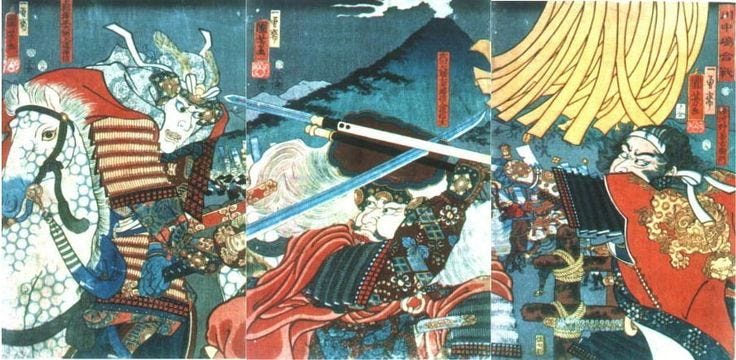
Another type of fighting fan was the tessen.
Tessen looked like ordinary folding fans, however the ribs of the fan, averaging 11 spokes, or the outermost ribs at least, were made of steel. Often slightly larger than the average folding fan worn at the waist, but still made with thick washi paper fan blades, these tessen being stronger and heavier could be used as a baton for defense, as a striking weapon. Some later tessen were simply batons of steel forged into the shape of a closed folding fan and were used in the same manner as a jutte (or jitte), a non-bladed baton-like defensive weapon. The art of fighting with war fans is known as tessenjutsu. The famed Yagyu clan, sword instructors to the Tokugawa shogunate included various fan related defensive moves in the curriculum of their school of martial arts, the Yagyu Shinkage-ryu.
In the classical Heiji Monogatari Emaki and Mongol Invasion Picture Scrolls, warriors such as Minamoto no Yoshitomo are seen carrying fans into battle. The great warrior Minamoto no Yoshitsune (c. 1159 – 1189) is said to have defeated the great warrior monk Saito Musashibo Benkei armed with a naginata, using only a tessen.
One of the great stories regarding the use of a tessen is told of Araki Murashige (1535-1586), who, while supposedly supporting Hideyoshi, made an insurrection against Nobunaga from his castle at Itami, near Osaka. According to a much-loved tale, after being accused of treason by Akechi Mitsuhide, Araki was called before Lord Oda Nobunaga. As was the custom, before entering Nobunaga’s audience chambers, he stopped at the threshold and bowed low. The story goes that Araki had sensed great danger prior to entering, and before bowing, had cleverly placed his iron ribbed tessen, folding war fan, in front of him as was the custom, but he placed it in the tracks of the sliding fusuma door. Nobunaga's plan was to have a guard slam the sliding doors on Araki’s head as he bowed, killing him. Araki’s fan preventing the doors from closing, and so his life was spared. Araki would later go on to become an apprentice to the great tea master Sen no Rikyu and come to serve Hideyoshi as a tea specialist. His tessen saved his life.
During the 1614 Winter Siege of Osaka, Matsudaira Naomasa, a grandson of Tokugawa Ieyasu, fought well against the Sanada clan around the area known as the Sanada-Maru, a large semi-circular fortified plot of land south of Osaka Castle that played a major role in protecting the Toyotomi held castle. Seven thousand Sanada samurai defended the Sanada-Maru.
Despite being on opposite sides, the warrior Sanada (Yukimura) Nobushige, much impressed by his adversary, threw his war fan to Matsudaira Naomasa in recognition of his bravery and fortitude during the battle. Incidentally, the winter Siege of Osaka was Naomasa’s first battle experience. He was only 14 years old at the time. The fan is now kept on display in the National Treasure listed Matsue Castle and was designated a Cultural Asset of Matsue in 1965.
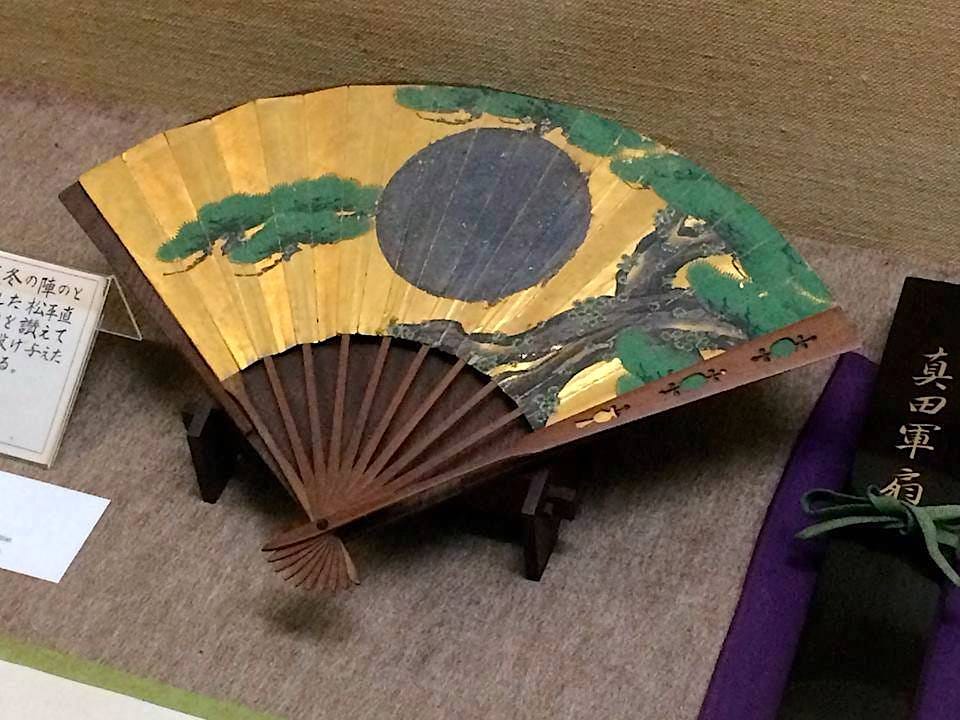
On the topic of fans, at the Battle of Sekigahara and also at the Siege of Osaka, the battle standard used by Tokugawa Ieyasu was a huge golden folding fan. The two-meter-wide fan with lacquered ribs used at Sekigahara remains in the collection of the Kunozan Toshogu Shrine in Shizuoka Prefecture. Made of gold leaf on thick, strong washi paper, a similar standard used at the winter and summer Siege of Osaka differed only in that it featured a large red rising sun motif, like the modern-day Japanese flag, in the middle of it.
In extreme cases, when a samurai was ordered to commit seppuku, as a form of punishment, instead of being given a small tanto blade to slice open his abdomen, he might be proffered a folding fan with which to perform the act, before being decapitated. Such a case, known as sensu-bara was seen as just one rank below the dishonor of being simply executed.
From this we see there is a long and deep custom of using fans. Knowing even a little about the importance of the fan, and their various uses within samurai society helps us understand their mentality and lifestyles a little better. This is particularly important for fans of the samurai.

